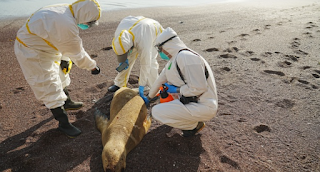
Credit SERNANP
#17,325
Less than a month ago (Feb 7th), Peru's SERNANP Reported At Least 585 Sea Lions & 50,000 birds killed by Avian Flu, a huge increase over the announcement by Peru's government the day before (see
SENASA: Peru Confirms H5N1 In 3 Sea Lions and A Dolphin).
This was followed up a few days later by a preprint examining the mass mortality event, which stated that given the size and clustering of these animal deaths, mammal-to-mammal transmission of the virus could not be ruled out.
All of this coming just two weeks after the Eurosurveillance report (see HPAI A(H5N1) Virus Infection in Farmed Minks, Spain, October 2022) which also presented evidence suggestive of mammal-to-mammal transmission of H5N1.
While we've seen literally hundreds of H5N1 spillover events to humans, and to other mammalian species, over the years, the virus has only rarely been reported to transmit onward. This lack of efficient and sustained transmission is a major obstacle the virus must overcome before it can pose a serious public health threat.
All of which makes H5N1-linked events like the mass infection among farmed mink, and sea lions in Peru (and potentially in a similar event in Russia in December), of considerable interest.
The longer the chains of transmission - the more likely that host-specific adaptations will accrue (see graphic of a classic serial passage experiment below) - which could improve the virus's virulence or transmissibility.
Late yesterday, in their first major update since early February, Peru's SERNANP (National Service of Natural Areas Protected by the State) announced a roughly 6-fold increase in the number of South Africa Sea Lions killed by H5N1 (n=3487).
(machine translated)
Sernanp reports sea lions affected by bird flu and continues with the surveillance and monitoring plan in protected natural areasPress release
It reiterates the call to the population not to touch or approach wildlife in general, to protect the well-being and integrity of people.
March 2, 2023 - 6:35 p.m.
Specialists from the National Service of Natural Areas Protected by the State (Sernanp), an agency attached to the Ministry of the Environment, recorded the death of 3,487 funny wolves (Otaria flavescens) in seven natural protected areas of the coast, which represents 3.29% of just over 105 thousand (Imarpe, 2020) of this species that inhabits the entire country. Likewise, the death of 5 fur seals (Artocephalus australis) has been reported, which represents 0.06% of the 8 thousand fur seals (Imarpe, 2021) registered in the natural protected areas of Peru.
This report includes a solid base of information from November 2022, which mainly covers the impact on the national reserves of Paracas (Ica); System of Islands, Islets and Guaneras Points (Lambayeque, La Libertad, Áncash, Lima, Ica, Arequipa and Moquegua) and Illescas (Piura).
Since the start of the H5N1 avian flu emergency, at least 63,000 dead birds have been detected in eight natural protected areas, the most affected species being boobies, pelicans and guanayes.
This virus is affecting countries like Bolivia, Uruguay and Argentina, and recently there have been reports of deaths of animals with symptoms similar to those found in Peru and diagnosed with bird flu, in northern Chile.
Prevention
Faced with this situation, in a preventive way, Sernanp is placing perimeter fences in some sectors where visitor access to the beaches is not restricted because they are tourist circuits, thus it has also been making an effective report on the affectation of wildlife.
This field surveillance plan has mapped risk areas and recognition of places with the presence of dead animals, through permanent routes and the use of drones; In these places, specialist personnel and park rangers have adequate implements for the proper and safe management and disposal of deceased fauna, possibly affected by H5N1 Avian Influenza. In this way, it seeks to reduce the threats of contagion, as well as minimize the exposure of the fauna present in those areas.
Sernanp has reinforced surveillance and activated its alert systems in all marine-coastal areas of the Peruvian coast, since positive cases of Highly Pathogenic Avian Influenza (HPAI) were detected in wild birds in the northern hemisphere, focusing efforts on breeding areas. for sea lions in the last days.
Finally, Sernanp again urges citizens to avoid approaching wildlife in general, keeping distance from specimens that are found dead or with some evidence of disease.
While there is understandably a great deal of concern over past and present GOF (Gain of Function) experiments on H5N1 (and other pathogens) in laboratories around the world (see here, here, and here), the largest unregulated, and largely unmonitored, laboratory in the world is nature.
Although it has had more than 20 years to play with H5N1, and has yet to produce a pandemic virus, it has more `building blocks' (i.e. genotypes, subtypes, infected hosts, and new species, etc.) to play with now.
Perhaps, as some have speculated, there is a `species barrier' that prevents H5 or H7 influenza viruses from fully adapting to humans. If so, great. But we can't afford to ignore the inroads these avian viruses have made into mammals over the past 2 decades.
Stay tuned.

